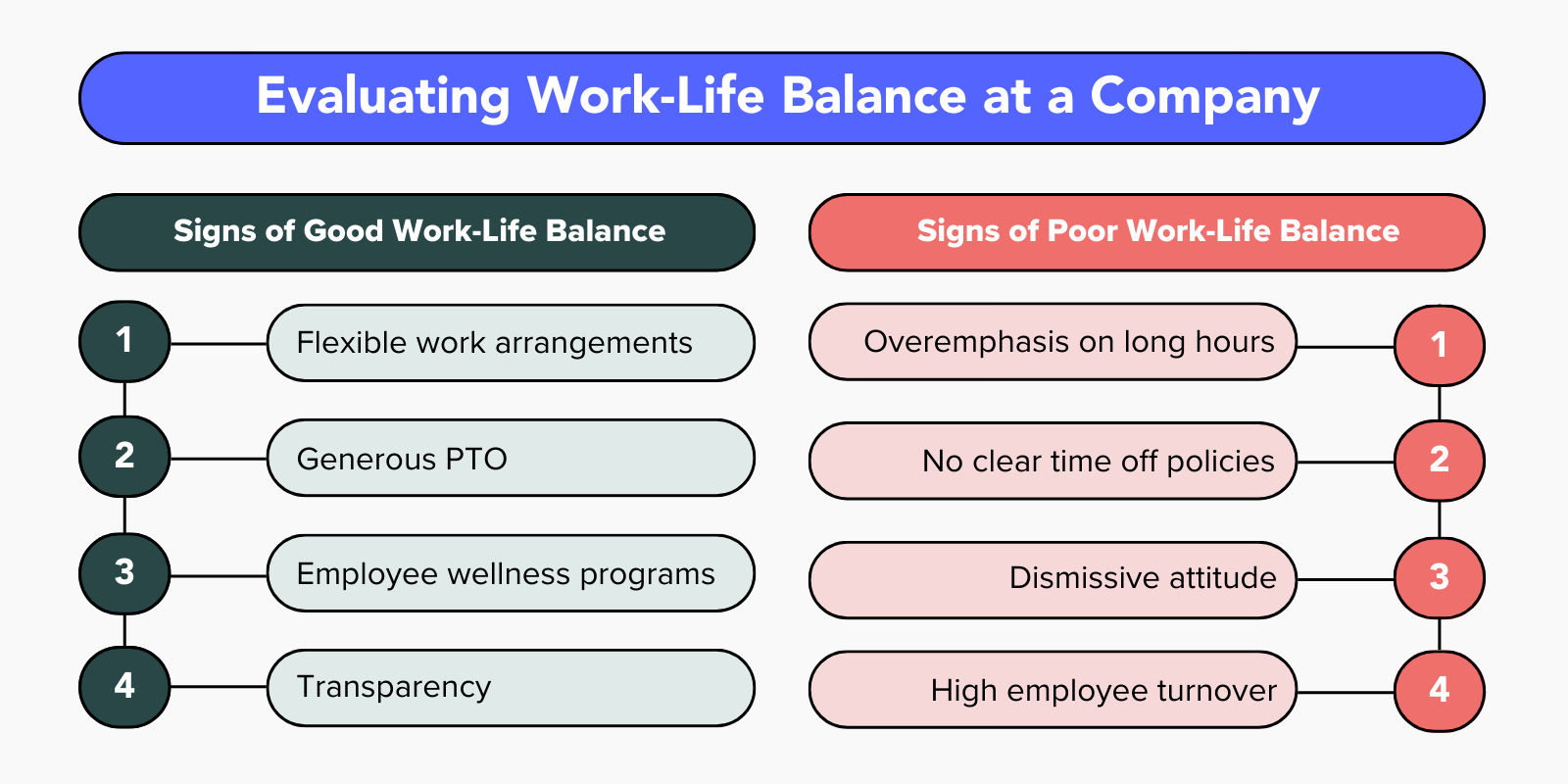Interviews are more than an evaluation of your skills and experience. It’s also your chance to learn more about the company and determine whether it’s a good fit for you.
Part of this means digging into the company’s culture and deciding whether or not it aligns with your priorities— especially when it comes to things like work-life balance. If having support and resources to balance your life in and outside of work is important to you, it’s worth doing your research and asking about it in the interview.
A study by FlexJobs found that out of the 42% of professionals thinking of quitting their jobs and the 20% who have recently quit, nearly a third did so because of poor work-life balance. Jumping back into the job market can be hard and costly, so taking the time to understand a company’s approach to work-life balance before getting hired can save you a lot of headache!
How to ask about work-life balance
Asking about work-life balance will help you better understand company culture and expectations— but there’s an art to it. If you ask too soon, ask the wrong questions, or are too persistent, you may send the wrong signal to employers.
Here are some things to keep in mind as you go into your interview.
1. Ask at the right time.
Timing your questions about work-life balance is key. Instead of leading with questions about time off, work it naturally into your conversations.
Some good points in your interview to ask include:
- Towards the end of the interview process: Typically, interviewers will ask if you have questions towards the end of the interview. This is an appropriate time to ask!
- When discussing company culture: If the interviewer touches upon the company’s culture or values during the conversation, you can use this as a segue to ask about work-life balance.
- When discussing expectations: If the interviewer brings up expectations for the role, such as working hours or overtime, it’s natural to ask about work-life balance. For example, you can ask about how the company supports employees in maintaining a healthy work-life balance while meeting job requirements.
- When asking about employee experiences: If you have the opportunity to speak with current employees about their experiences, you can ask about work-life balance.
Asking at the right time will help ensure that your questions will leave the right impression.
2. Ask the right questions.
In addition to timing your ask, it’s important to ask the questions that will help you truly understand how the organization value’s work-life balance.
Simply asking “Is the work-life balance good?” may illicit generic, one-word responses.
Instead, you should ask questions that allow you to evaluate work-life balance in action.
We asked Marylin Chapman, Director of Talent and Employee Experience at data.world, for some tips. She suggests asking one of the following questions to help you glean more information about the company’s priorities:
- How would you describe the work-life balance here, and how is it supported or encouraged by management?
- How does the company support employee well-being and mental health?
- What are some examples of how the company has adapted to support work-life balance during challenging times?
- How does the company handle time off? Can you tell me about the PTO policy?
- How does the team manage workload during peak periods and prevent burnout?
- What is the company culture like regarding work-life balance, and how is it reflected in day-to-day operations?
A company’s answers to these questions—and how they answer them—can be very telling and help you better understand how they prioritize employee well-being.
3. Be careful not to overemphasize it.
Even if a good work-life balance is your top priority when looking for a place to work, be careful not to overemphasize it in your interview. Being too concerned about things like time off and benefits, especially early in the process, can be off-putting—even to the most balanced employers.
Remember, at the end of the day, the main purpose of the interview is to show what you can do for the company, not the other way around.

Indicators of good work-life balance
So you’ve asked your questions. How can you tell whether a company will walk the walk or just talk the talk?
We asked Chapman to share some insights on how to assess a company and how they approach work-life balance.
Flexible work schedules
A company’s commitment to flexibility can be a big indicator of work-life balance.
“One way to tell if a company values work-life balance is by evaluating some basic policies that exist,” Chapman says. “Companies that are hybrid or fully remote are generally more comfortable with folks getting their jobs done than worrying about butts in seats.”
Are they strictly 9 to 5? Or do they allow employees to work according to a schedule that better suits their lives? Do they allow employees to work from home, or do they have a strict in-office policy? While remote policies or seemingly flexible hours don’t always mean a company has a healthy balance, it’s a good place to start.
Generous PTO policies
Having a paid time off policy— especially a generous one— is also a good sign.
“Of course, having paid time off policies is a telltale sign [of good work-life balance]!” Chapmans says. “Companies with open vacation— like data.world— truly want to ensure that folks don’t burn out and have a good balance of work and play.”
According to the Bureau of Labor Statistics, the average employee in the United States will have an average of 11 paid vacation days and 7 paid sick days after one year of employment. However, companies with generous PTO allowances may give employees upwards of four to six weeks of paid time off per year.
Some, like data.world, go a step further and have discretionary time off policies. This policy encourages people to take the time they need. Employees can take vacations, sick days, and mental health days without the worry of using up a limited bank of PTO.
Employee wellness programs
Time off isn’t the only benefit that can indicate a prioritization of work-life balance.
“Employee wellness programs tend to indicate a company’s commitment to employee well-being,” Chapman says.
These programs, which can offer resources for physical fitness, mental health, and financial well-being, demonstrate a commitment to the holistic well-being of the workforce. Companies that offer things like these often realize that a healthy employee equals a happier, more satisfied employee.
Transparency and understanding
An openness and willingness to communicate policies is always encouraging.
Even if a company isn’t the most flexible, their honesty about their policies and expectations is invaluable. A company that openly communicates its approach to work-life balance— even if it leans towards a more traditional or structured work environment— demonstrates respect for its employees’ needs and preferences.
Similarly kindness and understanding is important. Does the interviewer scoff and brush off your questions? Or do they approach with an understanding that you have a life outside of work? If an interviewer makes your questions and concerns feel valid, it’s a good sign.
Work-life balance red flags
On the other hand, some things in an interview can point to poor work-life balance— even if the employer says that balance is a priority.
Over-emphasis on long work hours
“A big red flag to watch out for in the hiring process can be something as overt as an overemphasis on long hours,” says Chapman. “For example, if the company culture glorifies working late or on weekends or being “passionate” to the point of overwork, it’s a concern.”
While occasional overtime may be necessary in certain industries, a consistent expectation of long hours can lead to burnout and negatively impact employees’ personal lives. Pay attention to whether the company promotes a healthy balance or if there’s an unspoken pressure always to be available.
No clear time off policies
“A lack of clear policies on PTO and flexibility can be telling as well,” Chapman notes.
Often, having no policies in place can be just as bad as having poor policies. It can leave employees feeling unsure about how to request time off or whether it’s even okay to do so.
Without straightforward guidelines, employees may feel hesitant to take much-needed breaks, leading to burnout and stress. Clear time off policies are like signposts that show employees it’s okay to recharge and take care of themselves outside of work. When a company lacks these, it could signal a gap in its commitment to supporting work-life balance for its employees.
Dismissive attitude around work-life balance
Remember, it’s not just what a person says but how they say it! Chapman reminds jobseekers to watch out for dismissive attitudes toward work-life balance questions during the interview process.
“For example, if the interviewer dodges or minimizes questions regarding work-life balance, it could be a sign that it’s not a priority for the company,” she explains. Employers should be transparent about their policies or expectations, no matter what they are.
High employee turnover
The last red flag is a high employee turnover.
“High turnover can be an indication that employees are dissatisfied, which is often due to work-life balance,” Chapman notes. Do a little research to get an idea of the company’s turnover rate and, if so, why they are leaving.
Look for patterns of employees leaving after short tenures. It may be because employees are being overworked, leading them to seek opportunities elsewhere.
Find the right balance for you
Asking about work-life balance in job interviews is crucial for understanding a company’s culture and priorities. By paying attention to red flags like long hours and dismissive attitudes and recognizing positive signs such as wellness programs and flexibility, job seekers can make informed decisions about their future workplaces.
